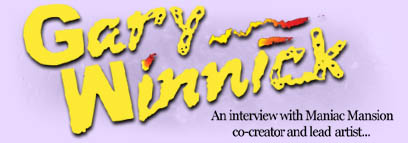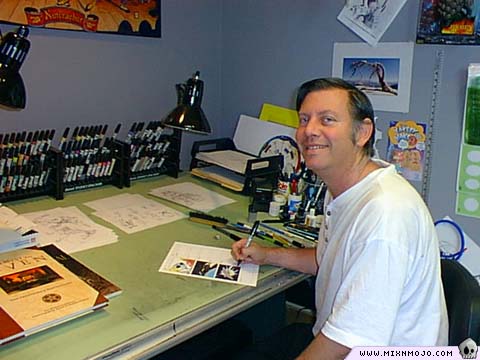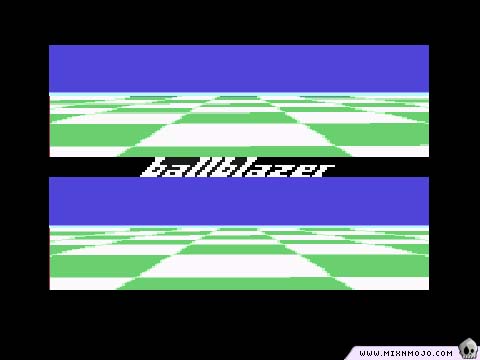Articles

Gary Winnick Interview Page One
Any LucasArts adventure game fan owes a lot to Maniac Mansion. It's the game that put LucasArts on the map and began a forumla for producing unique locations, weird story lines, interesting characters, and of course, an interface without typing. Recently, we conducted an interview with co-project leader and lead artist for this twisted classic. Here is your chance to learn more about the minds that teamed up a murderous meteor with talking tentacles and a nymphomaniac nurse. (Interview conducted by Andrew "telarium" Langley, Monday, August 20, 2001.)
Thank you very much for taking time out of your busy schedule to do this interview. First of all, why don't you introduce yourself and give us a little information on your background?

Well... I've been in the art, animation, game and content development business for the last twenty five years . My professional career began in 1976, when I traveled from California to New York with three artist friends Frank Cirocco, Brent Anderson and Tony Salmons. Frank and I ended up working at 'Continuity Associates' the studio of Neal Adams a well known comic book artist. We were there for about six months, upon our return to California Frank and I opened our own free lance studio in San Jose, 'Horizon Zero Graphiques'. We continued our association until I took a full time job as an artist/animator for the home computer division of Atari. After that I went to work at Lucasfilm Games, first as an artist, then art director and finally project leader. I was at Lucas for nine years before moving on to become the art director of Spectrum Holobyte. After leaving Spectrum I became a designer at Orbital Studios, a contract game development group I co-founded. Today I'm a partner in Lightsource Studios a free-lance art and animation company located in the bay area. I'm married and have three wonderful children, two boys and a girl.
Let's look back in the early 1980's when you started working at Atari. How difficult was it to go from illustrating comic books to creating art with just a few, large pixels?
Certainly in those days moving from traditional art and animation mediums was pretty challenging. Everything was more limited, the size of pixels were bigger, you had less of them to work with in fewer colors. I remember it was a big jump to go from four or five colors on the C-64 to a whole sixteen on the IBM PC! Of course we also had fewer total frames to devote to animation. You have to remember the kind of memory those computers had, going from 64K to 128K was a big deal. The ability to design something recognizable in few pixels and colors was reduced to creating fairly iconic straight on images (robots and brick walls are relatively easy) it was always hard to do anything at an angle. Motion could be made to look passable if you figured out the right combination of frames. When something moves more naturally you can fool the eye with a series of frames as opposed to individual bit maps that don't work well as single images. Color was also a big issue getting more colors to use and anti aliasing was a real help. Today's cheapest desktop machines blow away the highest end graphics machines we had for pretty much the entire time I was at Lucas.
When you were employed at Atari, what games did you work on? Anything well known?
That seems like a pretty long time ago... my recollection might be a little fuzzy. I was only there for about seven months. While at Atari the main product I remember being involved with was game based on the Superman III movie. You know the one with Christopher Reeve and Richard Pryor. At the time Warner Brothers owned Atari and it was a film based tie in product for the Atari 800 computer. It was pretty simplistic by today's standards. There was an evil computer in the middle of a scrolling playfield, the computer was this boxy orange thing with a face on it. There were various cities placed around it on the playfield and the computer would send out electrical probes that sucked power from the cities. The player as Superman had to fly around this scrolling background using heat vision to destroy the probes before they drained all of a city's power, otherwise the city caught on fire and melted. What happened is the movie came out before the game was completed and didn't do as well as they expected, so they killed the project. I remember a couple of other preliminary products, an animated puzzle for kids that never came out and some stuff for a proposed Wizard of Oz game. I worked exclusively on graphics for the 800, everything used character set based backgrounds overlaid with animated sprites.
What was it like working in the computer game industry when it was still in its infancy?
It didn't seem like it was in its' infancy although by today's standards it must look that way. When I first started out the most successful computer games were adaptations of action arcade games. Infocom was doing text based parser driven games. The industry was very cyclic going through extreme peaks and crashes such as VCS and 8 bit Nintendo gaming systems which the computer game industry emulated on a smaller scale. We were constantly looking at emerging new hardware and trying to second guess what was going to be the next big platform stuff like the Amiga or 3D0.
So in January of 1984, you were employed as the only graphic artist at the newly formed computer game division of LucasFilm. How did you get that job?

Charlie Kellner, a friend of mine who had been working at Apple became the fourth or fifth employee in the division. At that point they were all primarily software engineers and decided it was time to hire an artist/animator. Charlie thought of me and arranged a meeting with Peter Langston (the then head of the division) David Fox (Rescue on Fractalus) and Dave Levine (Ballblazer) at Siggraph to show them my portfolio. I met them for a follow up interview at their offices in San Rafael, I think they offered me a full time job a few weeks later.
What was the atmosphere like at LucasFilm Games when it was just starting out? Was it hard work? Did you guys have fun?
It was both, hard work and fun, before I had a family or any other type of life we all ate, slept and breathed computer games. In those days I felt I was working for the coolest company on the planet sandwiched in between ILM and Pixar. Every day was an adventure surrounded by some of the most innovative talent in computer graphics, science and motion pictures. Lucasfilm was a place everyone wanted to be, everyone gave 110%. It was one of the greatest experiences of my life.